
The Douglas fir is an evergreen conifer species in the pine family, Pinaceae. It is native to western North America and is also known as Douglas-fir, Douglas spruce, Oregon pine, and Columbian pine. There are three varieties: coast Douglas-fir, Rocky Mountain Douglas-fir and Mexican Douglas fir.

Mistletoe is the common name for obligate hemiparasitic plants in the order Santalales. They are attached to their host tree or shrub by a structure called the haustorium, through which they extract water and nutrients from the host plant.

The genus Arceuthobium, commonly called dwarf mistletoes, is a genus of 26 species of parasitic plants that parasitize members of Pinaceae and Cupressaceae in North America, Central America, Asia, Europe, and Africa. Of the 42 species that have been recognized, 39 and 21 of these are endemic to North America and the United States, respectively. They all have very reduced shoots and leaves with the bulk of the plant living under the host's bark. Recently the number of species within the genus has been reduced to 26 as a result of more detailed genetic analysis.
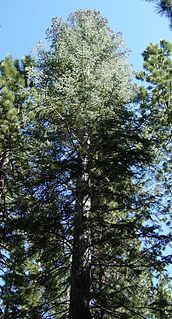
Abies concolor, the white fir, is a coniferous tree in the pine family Pinaceae. This tree is native to the mountains of western North America from the southern Cascade range in Oregon, south throughout California and into the Sierra de San Pedro Mártir in northern Baja California; east through parts of southern Idaho, to Wyoming; and south throughout the Colorado Plateau and southern Rocky Mountains in Utah and Colorado, and into the isolated mountain ranges of southern Arizona, New Mexico and northern Mexico. White fir live over 300 years and naturally occur at an elevation between 900–3,400 m (2,950–11,200 ft).

Calocedrus decurrens, with the common names incense cedar and California incense-cedar, is a species of conifer native to western North America. It is the most widely known species in the genus, and is often simply called 'incense cedar' without the regional qualifier.

Phoradendron is a genus of mistletoe, native to warm temperate and tropical regions of the Americas. The center of diversity is the Amazon rainforest. Phoradendron is the largest genus of mistletoe in the Americas, and possibly the largest genus of mistletoes in the world. Traditionally, the genus has been placed in the family Viscaceae, but recent genetic research acknowledged by the Angiosperm Phylogeny Group shows this family to be correctly placed within a larger circumscription of the sandalwood family, Santalaceae.

A parasitic plant is a plant that derives some or all of its nutritional requirement from another living plant. They make up about 1% of angiosperms and are found in almost every biome. All parasitic plants have modified roots, called haustoria, which penetrate the host plant, connecting them to the conductive system – either the xylem, the phloem, or both. For example, plants like Striga or Rhinanthus connect only to the xylem, via xylem bridges (xylem-feeding). Alternately, plants like Cuscuta and Orobanche connect only to the phloem of the host (phloem-feeding). This provides them with the ability to extract water and nutrients from the host. Parasitic plants are classified depending as to the location where the parasitic plant latches onto the host and the amount of nutrients it requires. Some parasitic plants are able to locate their host plants by detecting chemicals in the air or soil given off by host shoots or roots, respectively. About 4,500 species of parasitic plant in approximately 20 families of flowering plants are known.

The mistletoebird, also known as the mistletoe flowerpecker, is a species of flowerpecker native to most of Australia and also to the eastern Maluku Islands of Indonesia in the Arafura Sea between Australia and New Guinea. The mistletoebird eats mainly the berries of the parasitic mistletoe and is a vector for the spread of the mistletoe's seeds through its digestive system.

Olneya tesota is a perennial flowering tree of the family Fabaceae, legumes, which is commonly known as ironwood, desert ironwood, or palo fierro in Spanish. It is the only species in the monotypic genus Olneya. This tree is part of the western Sonoran Desert complex in the Southwestern United States, which includes flora such as palo verde, saguaro, ocotillo, brittlebush, creosote bush, and mesquite.
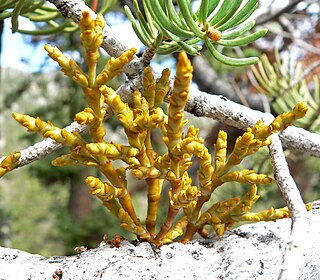
Arceuthobium abietinum is a species of dwarf mistletoe known as fir dwarf mistletoe. It is native to western North America from Washington to New Mexico to northern Mexico, where it lives in coniferous forests as a parasite on various species of fir, particularly white fir, giant fir, and red fir. This is a small shrub which is visible as a network of scaly yellowish stems extending above the bark of its host tree. Most of the mistletoe is located inside the host tree, attached to it via haustoria, which tap the tree for water and nutrients. The leaves of the mistletoe are reduced to knobby scales on its surface. It is dioecious, with male and female mistletoe plants producing spikes of staminate and pistillate flowers, respectively. The fruit is a sticky berry a few millimeters long which explodes to disperse the seeds it contains several meters away from the parent plant and its host tree.

Arceuthobium divaricatum is a species of dwarf mistletoe known as pinyon dwarf mistletoe. It is native to the southwestern United States and Baja California, where it lives in woodlands as a parasite on various species of pine, particularly Colorado Pinyon and Single-leaf Pinyon. This is a small shrub which is visible as a network of scaly brown or greenish stems no more than 12 centimeters long extending above the bark of its host tree. Most of the mistletoe is located inside the host tree, attached to it via haustoria, which tap the tree for water and nutrients. The leaves of the mistletoe are reduced to thin scales on its surface. It is dioecious, with male and female mistletoe plants producing spikes of staminate and pistillate flowers, respectively. The fruit is a sticky berry a few millimeters long which explodes to disperse the seeds it contains several meters away from the parent plant and its host tree.

Arceuthobium douglasii is a species of dwarf mistletoe known as Douglas fir dwarf mistletoe. It is native to western North America from British Columbia to Texas to California, where it lives in forest and woodland as a parasite. It is found mostly on Douglas fir trees, but occasionally on fir, as well.

Phoradendron californicum, the desert mistletoe or mesquite mistletoe, is a hemiparasitic plant native to southern California, Nevada, Arizona, Sonora, Sinaloa and Baja California. It can be found in the Mojave and Sonoran Deserts at elevations of up to 1400 m.
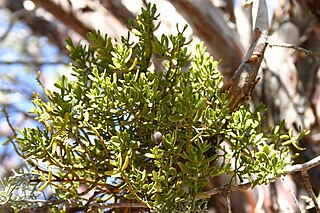
Phoradendron densum Trel. is a species of flowering plant in the sandalwood family known by the common name dense mistletoe. It is native to the western United States and northwestern Mexico, where it grows in various types of woodland habitat. It has been reported from California, Oregon, Arizona and Baja California. This mistletoe parasitizes species of cypress, including Arizona cypress, and juniper.
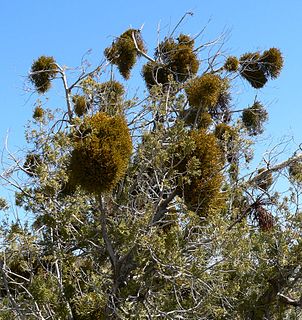
Phoradendron juniperinum is a species of flowering plant in the sandalwood family known by the common name juniper mistletoe. It is native to the southwestern United States and northern Mexico, where it grows in various types of woodland habitat. It has been reported from California, Nevada, Arizona, New Mexico, Oregon, Utah, Texas, Chihuahua and Sonora.
Phoradendron libocedri is a species of flowering plant in the sandalwood family known by the common name incense-cedar mistletoe. It is native to western North America from Oregon to Baja California, where it grows in forests on its host tree, the California incense-cedar.
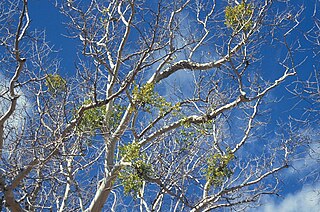
Phoradendron macrophyllum is a species of flowering plant in the sandalwood family known by the common names Colorado Desert mistletoe, bigleaf mistletoe, and Christmas mistletoe. It is native to western United States and northern Mexico from Oregon to Colorado to Texas to Baja California, where it grows in many types of wooded habitat at elevations up to 1700 m.

Phoradendron villosum is a species of flowering plant in the sandalwood family known by the common names Pacific mistletoe and oak mistletoe. It is native to western North America from Oregon south into Mexico, where it grows in oak woodland and similar habitat.

Phoradendron tomentosum, the leafy mistletoe, hairy mistletoe or Christmas mistletoe, is a plant parasite. It is characterized by its larger leaves and smaller berries than dwarf mistletoe. Leafy mistletoe seldom kill but they do rob their hosts of moisture and some minerals, causing stress during drought and reducing crop productions on fruit and nut trees. Leafy mistletoe has the ability to photosynthesize on its own but it relies on other plants in order to obtain its nutrients. It attaches itself to a tree and then grows haustoria, in order to get the food and water it needs.

Arceuthobium pusillum is a perennial, obligate parasitic plant in the sandalwood family. Its common names include Dwarf mistletoe or Eastern dwarf mistletoe. It is one of the most widespread dwarf mistletoes within its range which covers the eastern United States and Canada, from Saskatchewan to Nova Scotia and New Jersey. The species name "pusillum" derives from Latin "pusillus", meaning very small.



















